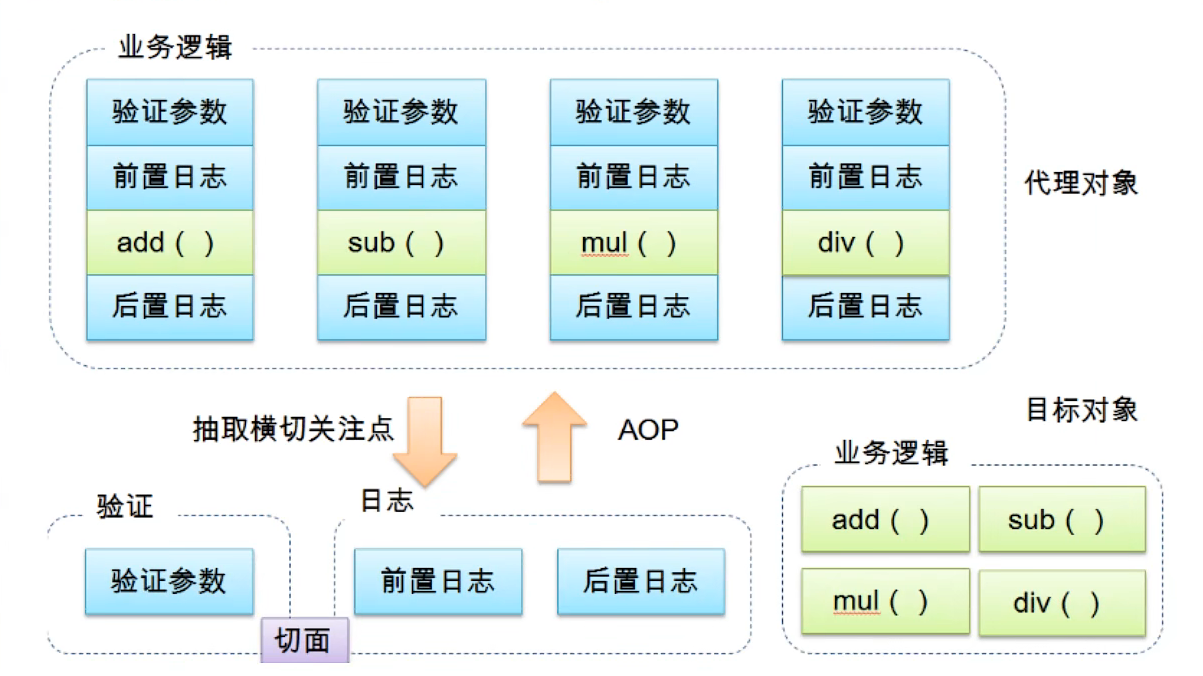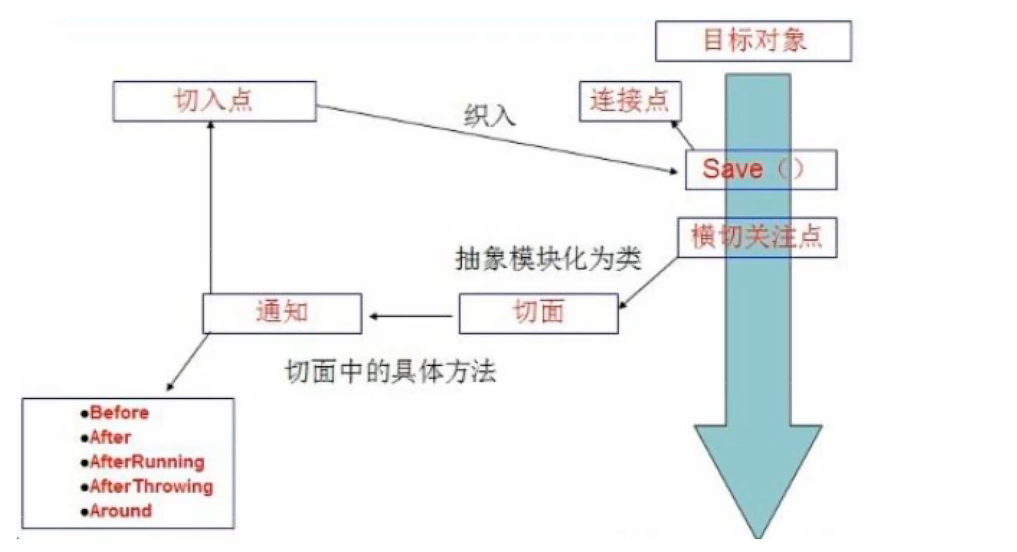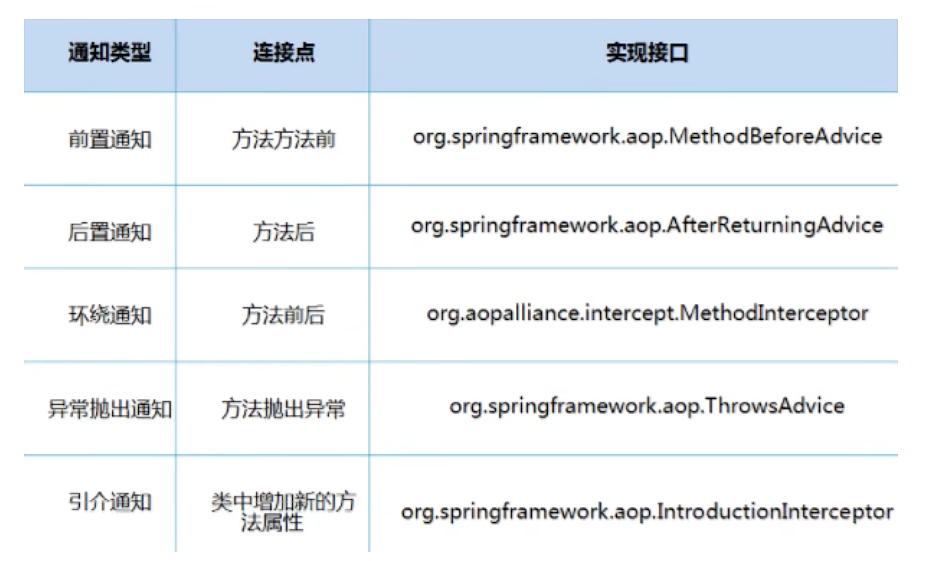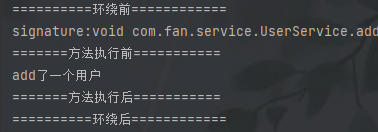Spring_AOP
什么是AOP?
AOP为Aspect Oriented Programming的缩写,意为:面向切面编程,通过预编译方式和运行期间动态代理实现程序功能的统一维护的一种技术。AOP是OOP的延续,是软件开发中的一个热点,也是Spring框架中的一个重要内容,是函数式编程的一种衍生范型。利用AOP可以对业务逻辑的各个部分进行隔离,从而使得业务逻辑各部分之间的耦合度降低,提高程序的可重用性,同时提高了开发的效率。

提供声明式事务,允许用户自定义切面
- 横切关注点:跨越应用程序多个模块的方法或功能。即是,与我们业务逻辑无关的,但是我们需要关注的部分,就是横切关注点,如:日志,安全,缓存,事务等等。。。
- 切面(Aspect):横切关注点,被模块化的特殊对象。即,它是一个类
- 通知(Advice):切面必须要完成的工作。即,它是类中的一个方法
- 目标(Target):被通知对象
- 代理(Proxy):向目标对象应用通知之后创建的对象
- 切入点(PointCut):切面通知 执行的“地点”的定义
- 连接点(JoinPoint):与切入点匹配的执行点

SpringAOP中,通过Advice定义横切逻辑,Spring中支持5中类型的Advice

使用AOP前,先导入依赖
<dependency>
<groupId>org.aspectj</groupId>
<artifactId>aspectjweaver</artifactId>
<version>1.9.9</version>
</dependency>
比如说,我么现在有个业务,CRUD
public interface UserService {
public void add();
public void delete();
public void update();
public void query();
}
public class UserServiceImpl implements UserService{
@Override
public void add() {
System.out.println("add了一个用户");
}
@Override
public void delete() {
System.out.println("delete了一个用户");
}
@Override
public void update() {
System.out.println("update了一个用户");
}
@Override
public void query() {
System.out.println("query了一个用户");
}
}
实现AOP的第一种方式,使用原生spring API接口
public class AfterLog implements AfterReturningAdvice {
@Override
public void afterReturning(Object returnValue, Method method, Object[] args, Object target) throws Throwable {
System.out.println("执行了"+method.getName()+"方法,返回结果为:"+returnValue);
}
}
public class Log implements MethodBeforeAdvice {
//method:要执行的目标对象的方法
//args:参数
// target:目标
@Override
public void before(Method method, Object[] args, Object target) throws Throwable {
System.out.println( target.getClass().getName()+"的"+ method.getName()+"被执行了");
}
}
<?xml version="1.0" encoding="UTF-8"?>
<beans xmlns="http://www.springframework.org/schema/beans"
xmlns:xsi="http://www.w3.org/2001/XMLSchema-instance"
xmlns:aop="http://www.springframework.org/schema/aop"
xsi:schemaLocation="http://www.springframework.org/schema/beans
https://www.springframework.org/schema/beans/spring-beans.xsd
http://www.springframework.org/schema/aop
https://www.springframework.org/schema/aop/spring-aop.xsd">
<bean id="userService" class="com.fan.service.UserServiceImpl"/>
<bean id="log" class="com.fan.log.Log"/>
<bean id="afterLog" class="com.fan.log.AfterLog"/>
<!-- 配置aop,需要导入aop的约束-->
<aop:config>
<!-- 切入点:expression:表达式 execution(要执行的位置 修饰词 返回值 类名 方法名 参数)-->
<!-- (..) 代表可以有任意个参数;-->
<aop:pointcut id="pointcut" expression="execution(* com.fan.service.UserServiceImpl.*(..))"/>
<!-- 执行环绕增加 pointcut-ref:引用切入点-->
<aop:advisor advice-ref="log" pointcut-ref="pointcut"/>
<aop:advisor advice-ref="afterLog" pointcut-ref="pointcut"/>
</aop:config>
</beans>
public class MyTest {
public static void main(String[] args) {
ApplicationContext context =new ClassPathXmlApplicationContext("ApplicationContext.xml");
//动态代理,代理的是接口
UserService userService = context.getBean("userService", UserService.class);
userService.add();
}
}

第二种,自定义类
public class DiyPointCut {
public void before(){
System.out.println("========方法执行前=========");
}
public void after(){
System.out.println("========方法执行后=========");
}
}
<bean id="diy" class="com.fan.diy.DiyPointCut"/>
<aop:config>
<!-- 自定义切面: ref 要引用的类-->
<aop:aspect ref="diy">
<!-- 切入点-->
<aop:pointcut id="point" expression="execution(* com.fan.service.UserServiceImpl.*(..))"/>
<!-- 通知-->
<aop:before method="before" pointcut-ref="point"/>
<aop:after method="after" pointcut-ref="point"/>
</aop:aspect>
</aop:config>

第三种,使用注解
import org.aspectj.lang.ProceedingJoinPoint;
import org.aspectj.lang.Signature;
import org.aspectj.lang.annotation.After;
import org.aspectj.lang.annotation.Around;
import org.aspectj.lang.annotation.Aspect;
import org.aspectj.lang.annotation.Before;
//方式三:使用注解方式实现AOP
@Aspect//标注这个类是一个切面
public class AnnotationPointCut {
@Before("execution(* com.fan.service.UserServiceImpl.*(..))")
public void before(){
System.out.println("=======方法执行前===========");
}
@After("execution(* com.fan.service.UserServiceImpl.*(..))")
public void after(){
System.out.println("=======方法执行后===========");
}
//在环绕增强中,我们给定一个参数,代表我们要获取处理切入的点
@Around("execution(* com.fan.service.UserServiceImpl.*(..))")
public void around(ProceedingJoinPoint jp) throws Throwable {
System.out.println("==========环绕前============");
//获得签名
Signature signature = jp.getSignature();
System.out.println("signature:"+signature);
//执行方法
Object proceed = jp.proceed();
System.out.println("==========环绕后============");
}
}
<bean id="annotationPointCut" class="com.fan.diy.AnnotationPointCut"/>
<!-- 开启注解支持-->
<aop:aspectj-autoproxy/>




 浙公网安备 33010602011771号
浙公网安备 33010602011771号